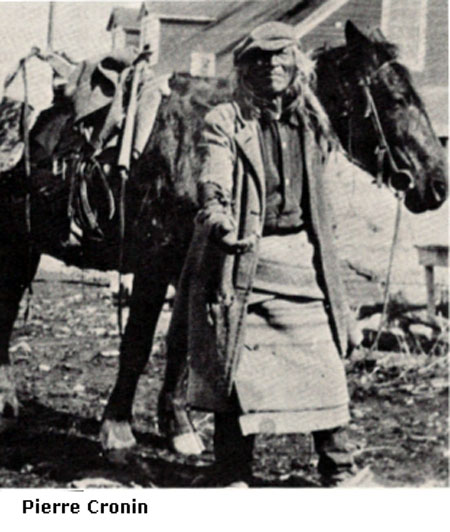

The Pierre Cronin Family (Indian Pete)
He was Chief Isadore's leading strong man in the raid on Wild Horse Creek in 1887, when they released Kapula from jail. This was during the gold strike near what is now called Ft. Steele.
When the North West Mounted Police came to the settlement, he considered them his bitter enemy. He hated the white man and also resented the representatives of the church. However, Father Coccola finally won him over when he refused to be intimidated by Pierre's threats of death, and a remarkable long lasting friendship sprang up between the Indian and the Priest.
Father Coccola constantly urged the Indians to watch out for chicamon or money rock. One day in 1893, Pierre returned from a hunting trip with a piece of heavy glittering rock. He told Father Coccola he had discovered a great ledge of this rock near Moyie Lake. The priest showed the rock to James Cronin who had mining in- terests in the district, and Cronin recognized it as high-grade galena. They lost no time in obtaining a miners licence at Fort Steele and with Pierre, Father Coccola and Cronin set out for Moyie Lake. Two claims were staked: the St. Eugene and the St. Peter. Half in terest to Cronin and half to the Priest and Indian Pete. Their share was finally sold for $12,500 and Father Coccola built his church and a comfortable house for Pierre at the Mission. The story goes that Pierre pitched his teepee inside his house and made a hole in the roof to allow the smoke to escape.
Pierre now did an unheard-of thing. He took the name Pierre Cronin, after his good friend.

When his discovery passed into the hands of the Consolidated Mining and Smelting Co., and became the famous St. Eugene Mine, Pierre was given a small Company Pension and certain rights. He claimed the right to sleep under the drafting office table, but more often slept in the warm manure pile behind the barn.
Once a month he rode into Kimberley, sometimes with his wife, but more often alone, to collect his small pension, believed to be $10.00, but he would visit all three cookhouses, at Chapman Camp, Townsite and Top Mine, where he would receive enough supplies - slabs of bacon, bags of flour, sugar, etc., to last him a month.
He died in 1926 at the age of eighty, and the company erected a granite head stone on his grave in the Mission Cemetery. Inscribed is:
Pielle Cronin
1846-1926
Kootenay Indian, discoverer of the
St. Eugene Mine
Moyie, B.C., June 30, 1893,
died May 17, 1926, aged 80 years.
"Pielle" was the Indian spelling for "Pierre".

